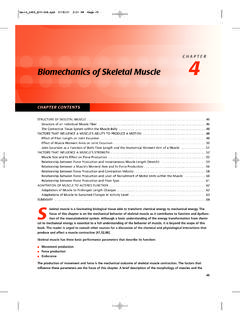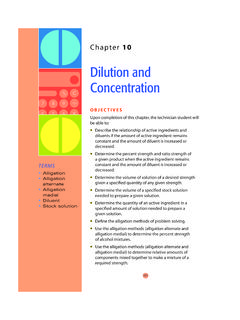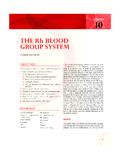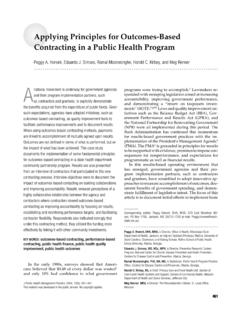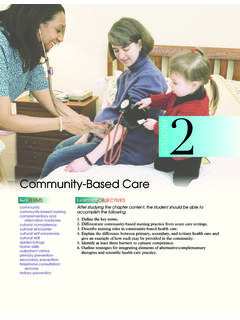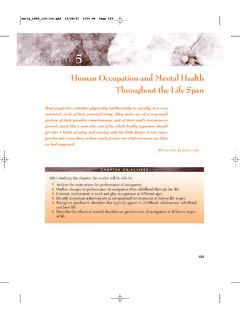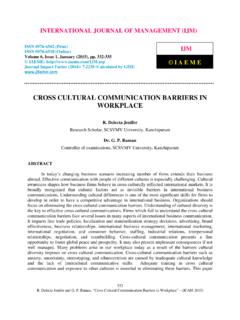Transcription of MODULE 3 Overcoming Communication Barriers
1 44 MODULE OVERVIEWB eing able to effectively communicate or participate in the exchange of informa-tion is an essential skill for dental health care providers. For many dental healthcare providers in the United States today, providing patient-centered care involveslearning to communicate effectively with patients even when various Barriers tocommunication are MODULE presents strategies for effectively communicating with: Patients who speak a different language than that of the dental health careprovider Patients with culturally influenced health behaviors that differ from thehealth care beliefs of the dental clinician Young and school age children Adolescents Older adults Vision, hearing.
2 Or speech impaired individualsMODULE OUTLINESECTION 1 Language Barriers46 cross - cultural CommunicationCultural CompetenceSECTION 2 Age Barriers50 Communicating with ChildrenCommunicating with AdolescentsCommunicating with Older AdultsSECTION 3 Vision and Hearing Barriers53 Communication with the Visually ImpairedCommunication with the Hearing ImpairedSECTION 4 Speech Barriers56 Communication with the Speech ImpairedCommunication when the Voice ImpairedSECTION 5 Ready References59 Internet Resources: cultural CompetenceInternet Resources: Hearing and Vision ImpairmentOvercomingCommunication BarriersMODULE 313747 11/22/08 12:22 PM Page 4445 Internet Resources: Voice and Speech ImpairmentEnglish Spanish Medical DictionariesModule ReferencesSECTION 6 The Human Element63 SECTION 7 Quick Questions64 SECTION 8 Skill Check67 Communication Skill Checklist: Communications Role-PlaySKILL GOALS Explain how the population has changed between 1980 and 2000 and describehow these changes affect dental health care.
3 Give an example of how cultural differences could affect Communication . Define cultural competence. Discuss effective Communication techniques for interacting with patients from differ-ent cultures. Discuss strategies that you can use to improve Communication with a child. Discuss strategies that you can use to improve Communication with an adolescent. Discuss strategies that you can use to improve Communication with older adults. Discuss strategies that you can use to improve Communication with visually, hearing-,and speech-impaired 11/22/08 12:22 PM Page 4546 PATIENT ASSESSMENT TUTORIALS: A STEP-BY-STEP GUIDE FOR THE DENTAL HYGIENISTSECTION 1 LANGUAGE BARRIERSCROSS- cultural COMMUNICATIONM ulticulturalism For many dental health care providers in the United States today, providing patient-centered care involves learning to communicate effectively with patients from non-English speaking communities and with cultural backgrounds that may be unfamiliar.
4 The United States has always had a significant foreign-born population, but the num-ber of foreign born reached an all-time high of million in 2002 equal to the population according to the Current Population Survey (CPS) .[1] The Canadian 2001 population census indicates that of the population inCanada is foreign-born. More than one-half of the 2002 foreign-born residents in the United States wereborn in Latin America with 30% from Mexico alone. 26% were born in Asia, 14% in Europe, and 8% in Africa and other regions. 2000 Census data show that over 47 million persons speak a language other thanEnglish at home, up nearly 48% since 1990. Although the majority are able tospeak English, over 21 million speak English less than very well, up 52% from 14million in 1990.
5 [2,3] By the year 2030, the Census Bureau predicts that 60% of the population willself-identify as white, non-Hispanic, and 40% will self-identify as members of otherdiverse racial and ethnic groups. Being competent to meet this Communication chal-lenge requires a set of skills, knowledge, and attitudes that enable the clinician tounderstand and respect patients values, beliefs, and expectations. Communication problems can easily occur if a patient is not fluent in English. Anindividual who is just learning the language may communicate well in everyday situ-ations. In the dental setting, however, the same person may not fully understandwhat is being and Foreign-Born Population, 1980 to 2000 [2,3] in change1980 11/22/08 12:22 PM Page 46 MODULE 3 Overcoming Communication BARRIERS47 The Minority PopulationAccording to the Census Bureau [1,2], the proportion of the overall population in theUnited States considered to be minority will increase from in 1995 to 2050 (Fig.)
6 3-1). According to the census data, between 1980 and 1990: African Americans increased from million to 30 million Asian Americans/Pacific Islanders increased from million to million Hispanics/Latinos increased from million to million Native Americans/Alaskan Natives increased from million to 2 millionCULTURAL COMPETENCEC ultural competenceis the application of cultural knowledge, behaviors, interper-sonal, and clinical skills to enhance a dental health care provider s effectiveness inmanaging patient care. cultural competence indicates an understanding of important differences that existamong various ethnic and cultural groups in our country.
7 Understanding patients diverse cultures their values, traditions, history, and insti-tutions is not simply political correctness. It is essential in providing quality patientcare. Culture shapes individuals experiences, perceptions, decisions, and how they relateto others. It influences the way patients respond to dental services, preventive inter-ventions, and impacts the way dental health care providers deliver dental care. In a culturally diverse society, dental professionals need to increase their awarenessof and sensitivity toward diverse patient populations and work to understand cul-turally influenced health States Population by Race/Ethnicity80%12%12%13%16%6%4%2%1%1%1 %11%6%72%64%1980 2000 2020 White* Black* Hispanic Asian/Pacific Islander* American Indian/Eskimo/Aleut**Excludes people of Hispanic originFigure 3-1.
8 Demographics of the United pie charts depict thechanging demographics of the United States population from 1980 to2020.[1,2]13747 11/22/08 12:22 PM Page 4748 PATIENT ASSESSMENT TUTORIALS: A STEP-BY-STEP GUIDE FOR THE DENTAL HYGIENISTC ultural DifferencesDental professionals interact with people from varied ethnic backgrounds and culturalorigins who bring with them beliefs and values that may differ from the health careprovider s own. Understanding cultural differences can aid Communication and thereby improve patient care. Preconceived ideas about a given culture can hinder a clinician from providing good care. Each patient is unique and his or her dental care needs differ.
9 Some cultures may beoffended by the intensely personal questions necessary for a health history and mayperceive them as an inexcusable invasion of privacy. People of various backgrounds also perceive the desirability of making direct eyecontact differently. To help avoid miscommunication and offending patients, dental health careproviders must be sensitive to these cultural differences. Recognize your own assumptions. Value diversity. Demonstrate an appreciation for the customs, values, and beliefs of peoplefrom different cultural and language backgrounds. Demonstrate flexibility. Carry out changes to meet the needs of your diverse patients. Communicate respect.
10 Do not judge. Show 3-1. Ways to Develop cultural CompetenceTips for Improving cross - cultural CommunicationCross- cultural Communication is about dealing with people from other cultures in away that minimizes misunderstandings and maximizes trust between patients andhealth care providers. The following simple tips will improve slowly, not down and be careful to pronounce words not speak loudly. A loud voice implies anger in many cultures. Speaking loudlymight cause the patient to become nervous. Use a caring tone of voice and facialexpressions to convey your not to ask double questions. Let the patient answer onequestion at a the message in different the patient does not understand a state-ment, try repeating the message using different words.
